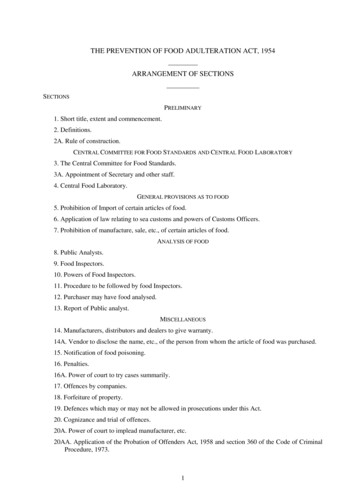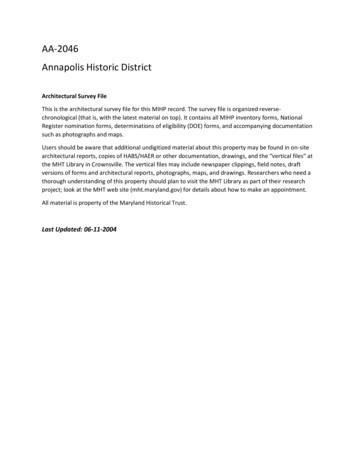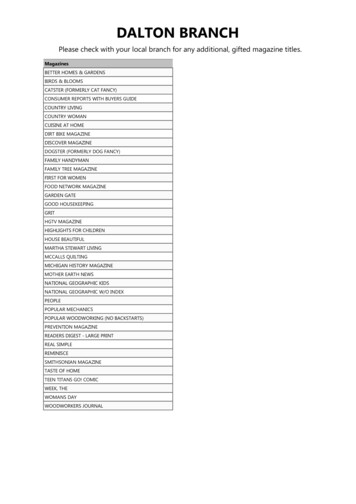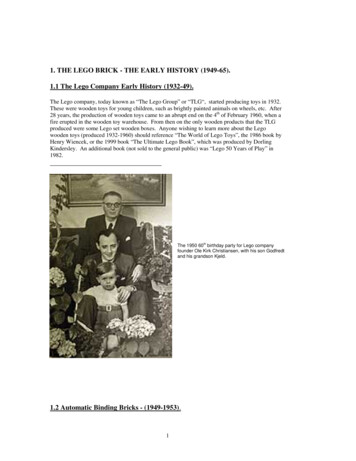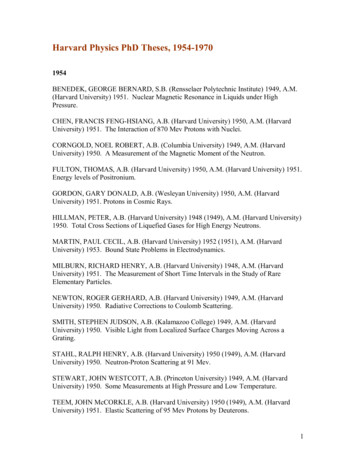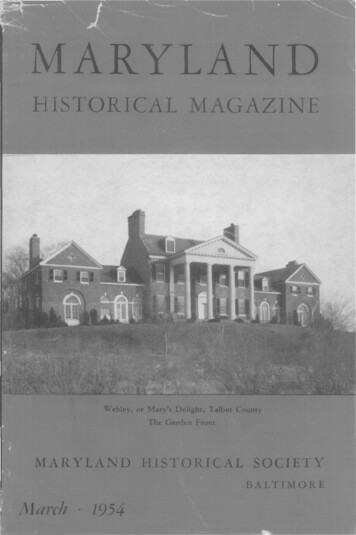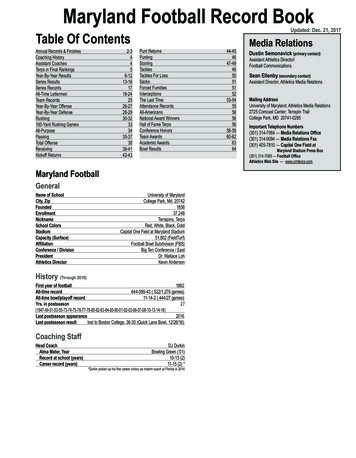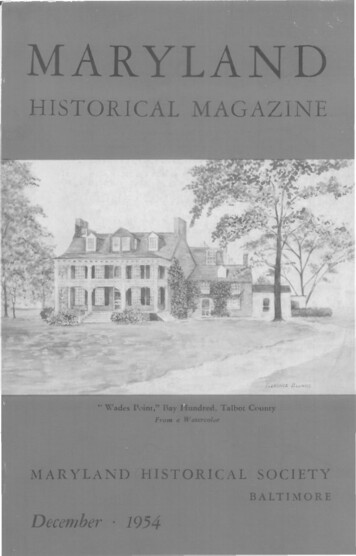
Transcription
ARYLANDHISTORICAL MAGAZINE,ifAjupmStT,1 II ir I illiJtTNfll%&'' rr «. IM';' u*mk NCC051/Wades Point," Bay Hundred, Talbot CountyFrom a WatercolorMARYLAND HISTORICAL SOCIETYBALTIMOREDecember 2934
Ivecipe for family securityTake your property and investments . . . add enoughlife insurance . . . place under our management asexecutor and trustee through an up-to-date will drawn byyour attorney—a will that reflects the many advantagesof careful estate planning.There you have a recipe for your widow's well-beingand security for your family.We invite you in confidence and without obligation todiscuss this important question with one of our officers.THE FIRST NATIONAL BANKOF BALTIMOREResources over 300,000,000Member: Federal Deposit Insurance Corp.[i o m fflJ
m5t) Sc 5 /-/-/? MARYLAND HISTORICAL MAGAZINEVOL.XLIX,NO,4DECEMBER,1954CONTENTSPAGEThe Unveiling of the Original Manuscript of The StarSpangled Banner259Thomas Kemp, Shipbuilder, and His Home, Wades PointM. Florence BourneLafayette's Visit in Frederick, 1824Dorothy Mackay Quynn290The Monday ClubWilliam D. Hoyt, Jr.301Edited hy Helen Lee Peabody314Revolutionary Mail Bag: IVReviews of Recent Books111332Annual Subscription to the Magazine 14.00. Uach issue 1.00. The Magazineassumes no responsibility for statements or opinions expressed in its pages.FRED SHELLEY,EditorThe Magazine is entered as second class matter, at the post office at Baltimore,Maryland, under Act of August 24, 1912.THE MARYLAND HISTORICAL SOCIETYH. IRVINE KEYSER MEMORIAL BUILDING201 W. MONUMENT STREET, BALTIMORE 1GEORGEL. RADCLIFFE, President; JAMES W. FOSTER, DirectorThe Maryland Historical Society, incorporated in 1844, was organizedto collect, preserve and spread information relating to the history ofMaryland and of the United States. Its threefold program includes1. Collection of manuscript and printed materials, maps, prints, paintings,furniture, silver, fabrics, maritime items, and other objects of interest;2. Preservation of these materials for the benefit of all who care to enjoy them,and exhibition of items which will encourage an understanding of State andNational history; and3. Spread of historical information relating to Maryland and the rest of thecountry by means of addresses at the Society's home by authorities in variousfields; addresses to outside groups by officers and staff of the Society; publication of the Maryland Historical Magazine, a quarterly containing originalarticles about State history; Maryland History Notes, a quarterly bulletin ofnews of the Society and other local historical items, the Archives of Marylandand the record of Maryland in World War II under the authoritv of the Stateand other serial and special publications.The annual dues of the Society are 5.00, life membership 100.00. Subscriptionto the Magazine and to the quarterly news bulletin, Maryland History Notes, isincluded in the membership fee as well as use of the collections and admission tothe lectures. The library, portrait gallery and museum rooms, are open daily exceptSunday, 9 to 5, Saturday, 9 to 4. June 15 to Sept. 15, daily 9 to 4, Saturday, 9 to 2.
W&TRADITIONALFURNITURE'CraditionalM&AMERICAN INDEPENDENCEPrestige, confidence, respect, are the natural outgrowth of a healthy SavingsAccount.From America's outstanding sources . , . in wideopen stock selection.BUILD YOUR FUTURE by steady, systematicsavings. You CAN have the finer thingsin life if you save for themlOur workroom offers completerestoration service . . . cabinetwork, refinishing and reupholstering.FRATERNITYFALLON & HELLENSAVINGS & LOAN DERAL764 Washington Blvd., Baltimore 3, Md.11 and 13 W. Mulberry St.Baltimore, 1, MarylandLExington 9-3345 INSURED LIBBERAL DIVIDENDS PARKING SAVE-BY-MAIL OPEN DAILY 9-2, SATS. 9-12 noon* SAVINGS RECEIVED BY the 10thearn DIVIDENDS FOR THE ENTIREMONTH.GENEALOGICAL CHAltTSS-\ - -:: " ':',, /.* ' «:'i5S . .-c.-:-:: . BBLwmHT1j- "&J-1 ——\' & . :.- .:i J—; an*::: :,:. : --i .?- ,.-" :-iiy Uy iF; -Si4:L- iaSizes and PricesChart16'1 32"20" 1 36"28" r 44"28"x 44"28" x 44"27" x 40"@@@@@@each51.251.501.752.5( 3.754.25Broadside "America"in Denby Type25"x 34" 3.00 eachDenby Chart Blanks—A blank form for listing ancestry(l) ARCHITECTURE.(2) PUBLICATION. \.b H nPNRY(3) TYPE & GENEALOGY, (4) MUSIC, 106 Songs / y ED IN H. PENBYBOOKS1. WATERCOLORSReproductions of Watercolors by Edwin H. DenbyPdomeduring travels over Europe, around the Mediterranean andthe Near East. A listing of many subjects In full color andsame halitones, with a few pages of text. Book 10.00bound, and separate chapters of it at 3.00 with papercarer.2, LINCOLNIANAA GREAT BOOK. A Symposium of many arts, MMMMpages, Eulogy on Washington by Lineola, Gettysburg Address, Lincoln's Farewell, America, Historic Meeting.Contains also Formulas for Lettering and Type la producethe striking poster pages. School Edition 2.75, Special 3.50, tteLme 4.50.3. TYPE BOOKS4. 100 SONGSPrinting and Genealogy, Valuable Hints, Speedy Calculations in Els, Schedules of Spacing, Properties and Advantages of the 1, details for slotting of type for betterSpacing through the EL Price 10.00.VICTOR HUGO, and great men, in many countries, foresee the future. They furnish text for many new SONGSnow available in the ' 'Solfamization" form with the melodyline. Enquire for details and List of Songs.THE COQ D'OR PRESS, Inc., 333 Fourth Ave., New York 10/ N. Y
MARYLANDHISTORICALMAGAZINEA QuarterlyVolume XLIXDECEMBER, 1954NumberTHE UNVEILING OF THE ORIGINALMANUSCRIPT OF THE STARSPANGLED BANNERIN the Main Gallery and adjoining Library of the Keyser Memorial, headquarters of the Maryland Historical Society, alarge audience assembled for the unveiling of the original manuscript of The Star-Spangled Banner. President George L. Radcliffeopened the meeting at 8:20 p. m. on September 14, 1954.MR. RADCLIFFE:Ladies and Gentlemen: You are present tonight to witness an outstanding event in the history of the Society.Before proceeding with the program I shall ask Father Driscoll to offerthe invocation.REV. WILLIAMM. J. DRISCOLL, S. J.:This historical manuscript is the first draft of the most famous expression of praise and devotion to our flag. It is our traditional salute toAmerica.259
260MARYLAND HISTORICAL MAGAZINEWe make to God this prayer today.Lord of Hosts, let us do for our country something even finer than thething that was done by Francis Scott Key. He paid to America a superbtribute in words. Help us to give her the great and more sublime saluteof deeds and actions—the living of our lives as true Americans.Yet more, O Lord: this Star-Spangled Banner and all it stands forwe love with our whole hearts. Protect it with Thy omnipotent power,cherish it with Thy infinite love; give peace and security to this land soprecious to us.Said Thomas Jefferson: " The last hope of human liberty in this worldrests on us." His words were never truer than they are today. Let ustake our stand beneath this Star-Spangled Banner and let us be firm inhope and grounded in courage. The bombs are still bursting in air;there is, across the world, the cannons' red glare; may our flag, always,imperishably, serenely, victoriously, be there—even as it was that night140 years ago tonight, when Francis Scott Key saw it continuously flying—through the night—until the dawn—until peace.This, O Lord, is our prayer. Offered at Baltimore, the birthplace ofthis glorious anthem, in Maryland, fair elder daughter of Americanfreedom.MR. RADCLIFFE:The eloquent prayer that you have just heard reflects the feelings ofall of us here for the unveiling of a manuscript, one of the most valuabledocuments in American history. Good fortune has been kind to ourSociety. When the fate of that manuscript was uncertain and a greatlibrary in another city was opening negotiations to obtain it, Mrs. ThomasC. Jenkins gave us all the money needed for its purchase.You are all aware that two years ago Mrs. Jenkins presented to theSociety a splendid collection of portraits of the Key family, includingone of Francis Scott Key, and also paid for all the expenses of fitting upthe Key Room in the Society's building.Now Mrs. Jenkins has made it possible for the Society to own thisfirst complete draft of The Star-Spangled Banner and has provided alovely setting for it which you will see in a few moments. The gift ofthe manuscript and the marble niche containing it are a memorial to thelate Mrs. George C. Jenkins, born Catherine Key, a cousin of Francis ScottKey. Mrs. George Jenkins was the mother of the late Thomas C. Jenkins,husband of our benefactress. The debt of the Society and of the community at large to Mrs. Jenkins is, indeed, beyond computation.There are present, I believe, many who are allied to Francis Scott Keyby descent or other close ties. His numerous descendants are living invarious parts of the Country. We also have with us several persons whohave devoted much study to the life of Francis Scott Key and to the Battleof Baltimore which called into being our National Anthem. Among themis the Honorable Edward S. Delaplaine, Judge of the Maryland Court ofAppeals, who wrote an able biography of Francis Scott Key. We regret
THE STAR-SPANGLED BANNER MANUSCRIPT261that Mr. Neil Swanson, author of the book The Perilous Fight, the storyof Maryland's participation in the War of 1812, could not be present.Our guest speakers will emphasize how this invaluable manuscriptwhich originated in Baltimore has always been preserved and cherishedin this city. In fact for many years it was in a house only a few feetfrom us, which has lately been acquired by the Society. The manuscriptnow finds a fitting and permanent home in the beautiful marble nichebuilt for it by our benefactress, Mrs. Jenkins.I now wish to introduce the distinguished Governor of Maryland, amember of the Maryland Historical Society and a devoted student ofhistory, the Honorable Theodore Roosevelt McKeldin.GOVERNOR MCKELDIN:Senator Radcliffe, Mrs. Jenkins, Distinguished Guests, Ladies andGentlemen: It is a great pleasure to be here on this important occasionwhen the Society dedicates the original manuscript of The Star-SpangledBanner in the handwriting of Francis Scott Key. I wish to congratulateMrs. Jenkins for making this wonderful gift to the Society and to thepeople of the State of Maryland.The motto of our State is usually expressed as " Womanly words,manly deeds." It has remained for Mrs. Jenkins to turn this mottoaround. We can all agree that this is an occasion of " Manly words,womanly deeds." (Applause)The permanent preservation of this manuscript here in Baltimore whereit was written is ground for the most sincere congratulations to all concerned. I am very happy that this wonderful document will be kept inMaryland and that it will be an inspiration to young and old of our State.I wish to express to you, Mrs. Jenkins, on behalf of the people of Maryland, our congratulations and our thanks for making it possible for thisprecious document to remain in our midst.MR. RADCLIFFE:Our Governor recently made an address in Philadelphia on the subjectof The Star-Spangled Banner which won well deserved praise.We have the pleasure also tonight of having with us the chief executive of Baltimore City, likewise a member of this Society. It is myprivilege to present the Honorable Thomas D'Alesandro, Mayor ofBaltimore.MAYOR D'ALESANDRO:Mr. President, Governor McKeldin, Mrs. Jenkins, Fellow Citizens: Itis entirely fitting and proper that this original manuscript of our NationalAnthem should be here in Baltimore where it rightfully belongs.Everyone who visits Fort McHenry must feel the same emotions experienced by Francis Scott Key, as he witnessed the attack on the fort.The City of Baltimore and the State of Maryland owe a great debt ofgratitude to Mrs. Thomas Courtney Jenkins, whose civic-minded generosityhas made this historic gift to the Maryland Historical Society possible.
262MARYLAND HISTORICAL MAGAZINEThe gift constitutes a memorial to Catherine Key Jenkins, a cousin ofFrancis Scott Key, and will forever remain a memorial, both to FrancisScott Key and his cousin.On behalf of the citizens of Baltimore, I desire to express my officialand personal thanks to the donor of this priceless document, Mrs. ThomasCourtney Jenkins.In these days, when patriotism is so sorely needed, just a look at thismanuscript should make better Americans of all who behold it. May itever be a reminder of the heroism and patriotism of the defenders ofFort McHenry in 1814.MR. RADCLIFFE:Thank you, Mr. Mayor, for your very instructive and appropriateremarks. AH of us echo the sentiments you have expressed so eloquently.When this occasion was being planned we felt that in addition toAdmiral Hill, and the gentlemen you have just heard, there should bean authoritative voice to describe the events that led up to the writingof The Star-Spangled Banner by Francis Scott Key—to tell us just howit happened. No one could do this so well, we believed, as Dr. GeraldW. Johnson, author of many works of biography and history, and an ableand popular television commentator. I take pleasure in presenting Dr.Johnson.DR. JOHNSON:Mr. President, Distinguished Guests, Ladies and Gentlemen: The StarSpangled Banner is unique among national anthems in several respects.It is the only one inspired by a single military action. It is the only onewritten by a poet who stood on the wrong side of the battle line. It is theonly one whose mood passes from anxiety, through exultation, to end indedication. Like the Marseillaise its eyes are fixed on the glories of thefuture, rather than those of the past. Like God Save the King it has areligious overtone. Like The Watch on the Rhine it is grimly resolute.But in combining these qualities it becomes unique, and this singularity iseasily traceable to the circumstances of its composition.To a man of the 20th century those circumstances seem odd to theverge of the fantastic. Here we find a lawyer allowed to appear beforethe admiral commanding a hostile fleet, to argue the law of nations inbehalf of a civilian prisoner charged with hostile acts against an invadingarmy. Not only was he heard, but the admiral, his second in command,and the commander of the troops in the landing force, after due delibration agreed that his argument was sound and ordered the release of theprisoner. All concerned took it for granted that every military force,even an invading army, is bound by the rules of civilized warfare.This seems strange today because since 1814 both Americans and Britishhave had a fearfully thorough education in the military policies of savagery. Nurse Cavell and Louvain began to teach us in the first WorldWar, and in the second the Death March on Bataan, Malmedy, Lidice,and the Polish officers in the dreadful forest completed our education.
THE STAR-SPANGLED BANNER MANUSCRIPT263We have been instructed out of all comprehension of the relatively civilized 19th century.It is necessary to try to recapture the spirit of that time in order tounderstand the series of events that produced our National Anthem. Asthe British army under General Robert Ross withdrew after its raid onWashington, some drunken soldiers straggled away from their outfitsand trespassed upon the property of Dr. William Beanes in Upper Marlboro, and the indignant doctor demanded their arrest by local peaceofficers which seems to have been effected. If anything like that occurredtoday, the subsequent proceedings would have been quite simple. Theofficer commanding the next detachment would release the soldiers andhave the doctor shot along with the officers making the arrest. But thecivilized invader of 1814 merely took the doctor into custody and apparently did not molest the constables at all.Even so, it was felt that he had exceeded his authority, and Dr. Beanes'friends promptly retained a lawyer to get him out of the jam. That iswhy Attorney Key, of Georgetown, having secured authorization fromPresident Madison, came to Baltimore to pick up John S. Skinner, American agent for the exchange of prisoners, whose presence would makethings regular, and took a small ship down the Bay right into the midstof the enemy fleet. Admiral Sir Alexander Cochrane, commanding, respected Key's flag of truce, and with Rear-Admiral Sir George Cockburnand General Ross, heard the case, decided that the doctor had not, infact, committed an act of war, and ordered his release.But even in 1814 there was a limit to courtesies in an active theaterof war. Cochrane was about to attack Baltimore, and he could not allownews of his preparations to be carried back to the city; so he put thethree Americans in their own ship under guard of a squad of Marines,and when the attack began put the ship in a safe place and held it untilthe affair should be finished. That is how Key came to watch the battlefrom the wrong side of the lines.He saw nothing of the bloodiest and really decisive part of the fighting.That occurred on the 12th, when Ross landed his army and attempted totake the city from the land side. General Samuel Smith with the mainarmy waited for him in entrenchments thrown up on the hill of whichPatterson Park is now a part; but he screened his position with threethousand militia under General John Strieker, who were posted acrossthe neck of land known as North Point. This screening force Rossstruck and drove back upon the main body, which was what GeneralSmith had expected. What he had little reason to expect was that Striekerfought a delaying action so furious that Ross was killed and his armybadly mauled before the main position was uncovered. Colonel Brooke,Ross' successor, realized that he had not strength enough left to carrythe works by assault, so he called on the fleet to move up and blast Smithout of his entrenchments.This was the operation that Key observed from his position down theharbor. To carry it out Cochrane had first to reduce the fort on Whetstone Point and the shore batteries on either side; so he moved up and
264MARYLAND HISTORICAL MAGAZINEfor twenty-five hours bombarded the fort with everything he could bringto bear. The fort could make no effective reply because the range of itsguns was too short, so Colonel Armistead, commanding, simply stoodand took it.From the morning of the 13th until midnight the cannonading wasincessant; then it paused long enough for a landing party in small boatsto make a dash for the shore behind the fort, but the small boats raninto fire from batteries at what is now Port Covington and were beatenback with loss. So the bombardment was resumed and continued the restof the night.That is what the three Americans were watching from behind theBritish line. For Skinner and Dr. Beanes it must have been an unforgettable day and night, but for Francis Scott Key it was terrific. In thefirst place, he was a high-strung romantic young man who felt everything intensely and was fond of expressing his feelings in verse, usuallyvery flowery and fanciful. In the second place, he alone of the three hadwitnessed what happened to Washington when the British struck and hemust have believed that one more such blow would just about finish theAmericans.But for twenty-five hours he could hear plenty but could do nothingand could see little. His heart almost failed him about midnight, whenthe firing suddenly stopped; it actually meant that the landing party wastrying to get ashore, but it might have meant that the flag had been hauleddown. But when a hellish din broke loose behind the fort, where theshore batteries were working on the boats, it became clear that the fightwas not over.But in the cold, gray dawn everything stopped again and this timethere was no resumption. The battle was finished, but who had won?As the light strengthened and the morning mist thinned, the outlines ofthe fort slowly appeared. The tall flagstaff carried a flag, but it hunglimp in the windless air and no one could identify it. A puff stirred it,and another, but not enough to show its design; at last though, the realmorning breeze came, caught it, lifted it, flung it wide—and Key's straining eyes were staring at " broad stripes and bright stars."That explains why the American national anthem begins in suspense,torn between hope and fear, proceeds into stern defiance, bursts into wildexultation and then, as the smoke of battle drifts away, ends in a prayer:Oh! thus be it ever when freemen shall standBetween their loved homes and the war's desolation!Blest with victory and peace, may the heaven-rescued landPraise the Power that hath made and preserved us a nation.Within twenty-four hours all Baltimore was singing the words to thepopular tune of Anacreon in Heaven, and the song swept the country.It has been resounding ever since. In the generations since many otherpatriotic songs have risen and fallen in popular favor but none has displaced this one, for no other so perfectly represents the hopes and fears,the resolution and the aspiration that have characterized our people and
THE STAR-SPANGLED BANNER MANUSCRIPT265that, under the Power that Key acknowledged, created the spirit "' thathath made and preserved us a nation."MR. RADCLIFFE:Mr. Johnson has given us a vivid picture of the events that inspiredKey to compose The Star-Spangled Banner. Thanks to his brilliant interpretation, we can all better realize the emotions that Key expressed in hisimmortal words.It is now my pleasant duty and great privilege to introduce our principalspeaker who will tell us something of the meaning of The Star-SpangledBanner in the lives of people living today. He is one of the outstandingmen of the last war and a man who has shown his devotion to Marylandby writing a book about important events in our history, as you all know.He has just returned to Maryland to live here after a distinguished careerthat began when he entered the Naval Academy. He once served as a juniorofficer on the old battleship Maryland, and her successor of the same namewas his flagship in the Pacific Theatre. He had an outstanding recordin World War II — I need only mention the engagements at Tarawa,Eniwetok, Saipan, Tinian, and Okinawa. He received the DistinguishedService Medal no less than three times. He has been superintendent ofthe Naval Academy and commandant of the National War College. Ihave the honor to present Admiral Harry W. Hill.ADMIRAL HILL:Senator Radcliffe, Governor McKeldin, Mrs. Jenkins, Ladies and Gentlemen; I consider it a great privilege and honor to be present on thismemorable occasion and to join with you in dedicating an evening of ourlives to the appreciation of this glorious anthem and the flag for which itstands.How many times have you, as individuals, asked yourselves what TheStar-Spangled Banner means to you? We celebrate a Flag Day, but formost of us I am afraid that is like Thanksgiving Day—one day in theyear in which we think of, and give thanks for, the many blessingsAmerica has bestowed upon us—and then we go blissfully through 364more days taking everything for granted.I am sure that most of you have experienced the thrill of seeing thestars and stripes in a foreign port—and have felt that tingling of the spineat the sound of our National Anthem's stirring music and its inspiringwords. To us, in this present day, they bring a sense of security, andfreedom, and a guarantee of our way of life.But at the time they came into existence, both the flag and the anthemsymbolized a desperate struggle, against enormous odds, for survival as anation, and for protection of the freedoms with which we are now sorichly endowed. Hence the theme of joy, thankfulness, and exaltation atthe occasional glimpses of the flag during the bombardment.In the last stanza of this immortal song, Francis Scott Key definesthis as a struggle by freemen for defense of their homes and loved ones.
266MARYLAND HISTORICAL MAGAZINEHe expresses his concern over this struggle, and gives acknowledgment toDivine guidance for national victory " when our cause it is just." Healso asks that we " praise the Power that hath made and preserved us anation."And so this anthem, and our beloved flag, become the symbols ofeverything we Americans hold dear—our nation, our homes and lovedones, our freedoms, and our way of life. They represent the glorioustraditions of our forefathers and the hopes for the continued greatnessof America in the future. They are reminders of the fact that, both asindividuals and as a nation, we should seek Divine guidance in our dailylives. Every rendition of The Star-Spangled Banner, or sight of the flag,should stir our national pride, and inspire us to be better Americans.Never in the history of the world has a nation been so endowed withthose things which insure security, prosperity, and the five freedoms, toall its citizens. We are indeed a fortunate people, and should be humblygrateful.In return, our country asks only that we be good citizens. Of the greatvariety of ways open to us for accomplishment of that task, I wish totell you briefly of two impressive examples I have encountered.During the war I had as a member on my staff a man who had been bornin Sweden, and who as a young man had come to America. He was quitepoor and eventually settled in Alaska, where during the years he did welland became one of the prominent citizens of that territory. He had beena member of the Naval Reserve, and immediately when war was declared,applied for active duty. I have never talked to a person who was soproud and appreciative of being an American as he was. I used to delightin talking to him about it because he was so sincere and honest in hisfeelings in the matter. America had taken him in as a poor boy and hadbefriended him. From his point of view there was nothing too much togive America in return—his home, his property, his very life—all thesehe would willingly have laid on the altar of appreciation for the privilegeof being an American citizen.I want to tell you about another man with whom I came in contactduring my recent experience as Governor of the U. S. Naval Home inPhiladelphia. This man was a man who had served for thirty years asan enlisted man in the Navy, commencing with the Spanish War. I wastalking to him in my office one day and was inquiring about his familyconnections. He had no family—all his kinfolk were dead. I happenedto know that he had about 2,000 to his credit on the books, and duringthe course of the conversation I asked him what he was going to do withthat when he died. He said, "" Well, Admiral, not long ago I saw somestatement to the effect that the individual share of the national debt wasabout 1,700 or 1,800. You know. Uncle Sam has been awful good tome in my life and all the years I spent in the Navy. I have alwayswondered how I could pay that back in some way. So I have written intomy will that on my death this money that I have is to be paid to theTreasurer of the United States in settlement of my share of the nationaldebt." Now that man certainly showed me a tremendous sense of appre-
THE STAR-SPANGLED BANNER MANUSCRIPT267ciation for the privilege of being an American, and I can't imagine anybetter lesson in how to be a good citizen than the one he provides.Maryland produced a national hero who gave us an example of goodcitizenship which should be more generally applied today. I refer toStephen Decatur. He was a man well experienced in international affairs—a statesman as well as a naval officer. His philosophy of good citizenshipwas summed up briefly in his famous toast in 1815—" Our country! Inher intercourse with foreign nations may she always be in the right! Butright or wrong, our country! "This is a free country and individual opinion is not only allowed, butencouraged. In the Navy, before a decision is reached by the Commander,a frank and open discussion has been had with appropriate members ofhis staff. But when he has made his decision—we demand that everyonegive full loyalty to that decision, just as if it were his own.That is something we need more of in this country today. Althoughnot so evident as it was in those days 140 years ago—our nation is againin a terrific struggle. This time it is a cold war—a struggle against anideology which does not believe in Divine guidance and which woulddestroy all that The Star-Spangled Banner stands for. Many years ofthis struggle lie ahead, and it is essential that we, as '.tizens, acquaintourselves with the problem, and if we have opinions, present them throughthe normal channels rovided. But once a decision is reached, let us alladopt Decatur's philosophy, and throw our strong and unqualified supportto our President and his advisors in their conduct of our foreign policy.A unified opinion at home is essential if our diplomats on the front linesof this struggle are to succeed.One other very important function for us as citizens is in the home, andinvolves the training of the younger generations in the high ideals I amsure all of this audience believe in. We hear much these days of juveniledelinquency, and other problems of youth. These things stem directlyfrom the home, and the lack of home training. It is a serious problemfacing every community, but a solution for it must be found.From the long range point of view, I believe that one of the importantkeys to its solution lies in the very thing to which we are paying homagetonight—The Star Spangled Banner and the flag for which it stands.Require that our National Anthem be played at all public gatherings.Conduct a drive from the pulpit, press, and particularly in the schools,with a view to instilling in our people a greater appreciation of theirprivilege of being Americans. Inspire them with a strong spirit of nationalism, and a fierce pride in their flag and all it stands for. Trainthem to have respect for our President, and those in Washington whoare re
late Mrs. George C. Jenkins, born Catherine Key, a cousin of Francis Scott Key. Mrs. George Jenkins was the mother of the late Thomas C. Jenkins, husband of our benefactress. The debt of the Society and of the com- munity at large to Mrs. Jenkins is, indeed, beyond computation. There are present, I believe, many who are allied to Francis Scott Key

